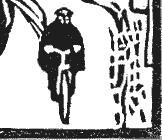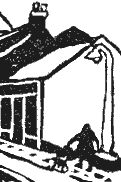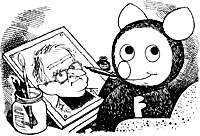|
It's hard to believe that in the late 1960s
there was virtually nothing available locally in the way of photocopying
and a linocut was one of the few options for printing cards at home.
Looking at this design now, I can see lots
of possibilities: I like the balance of blank with  busy
areas, I like the two characters in the street. I used to work as
a temporary postman at Christmas so I had ridden down Queen Street
on a GPO bicycle, like the postman in the picture. busy
areas, I like the two characters in the street. I used to work as
a temporary postman at Christmas so I had ridden down Queen Street
on a GPO bicycle, like the postman in the picture.
 But
I also remember being frustrated with some of the limitations. I
liked to include detail then, just as I do today. Working in reverse
- you cut away the white areas, rather than 'draw' in the darks
with linocuts - I found the proportion of details like the lamp-post
difficult to control. But
I also remember being frustrated with some of the limitations. I
liked to include detail then, just as I do today. Working in reverse
- you cut away the white areas, rather than 'draw' in the darks
with linocuts - I found the proportion of details like the lamp-post
difficult to control.
Today I love the funky, graphic feel this
slightly out-of-control medium gives the image but at the time,
if I could have used some printing technique that allowed me to
work in detail, then that is what I would have gone for. I realise
now that the limitations of this medium would have been a good influence
on my artwork.
|
| In between packing books
today, I'm making my own Christmas cards. I've done this for
years; one of the first, which dates from around 1968 or 1969,
is the linocut I made of Queen Street,
Horbury. Thirty years later, with an opportunity to print
in colour, I used this watercolour of the Victoria Prize Band
playing on Christmas Eve at the bottom end of the street.
The purer blues and yellows that had given my watercolour
a Christmassy feel were lost in reproduction and I prefer
the linocut because it's has a more striking, graphic quality
to it. |
 |
I used my mum's lino-cutting tools, which she'd bought
for a college project when she was at Ripon in pre-war years. |
|
|
|
I'd begged an old pattern
book of lino from a local shop. The size of each sheet was
just right for the cards I produced. |
 Flook
by Trog Flook
by Trog
A daily influence on my black and white artwork was the Flook
cartoon strip by Trog in the Daily Mail. I don't remember
the whimsically satirical stories being very compelling (they probably
went over my head, most of the time) but I liked his use of thicker
and thinner lines. He'd occasionally draw some subject such as a
terraced house in the course of the strip, and I found myself trying
to use his approach for graphics projects in my early days as an
art student. 
Link
Trog
(Wally Fawkes) retired in June this year, aged 81, after 62 years
as a cartoonist, article from Camden
New Journal.
Richard Bell, richard@willowisland.co.uk
|